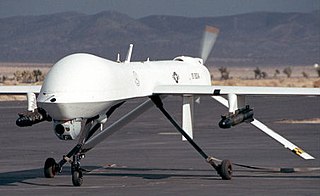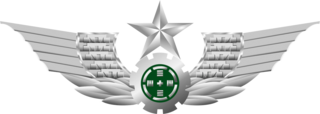
A military aircraft is any fixed-wing or rotary-wing aircraft that is operated by a legal or insurrectionary armed service of any type. Military aircraft can be either combat or non-combat:

Military technology is the application of technology for use in warfare. It comprises the kinds of technology that are distinctly military in nature and not civilian in application, usually because they lack useful or legal civilian applications, or are dangerous to use without appropriate military training.

Military robots are autonomous robots or remote-controlled mobile robots designed for military applications, from transport to search & rescue and attack.

An unmanned combat aerial vehicle (UCAV), also known as a combat drone, colloquially shortened as drone or battlefield UAV, is an unmanned aerial vehicle (UAV) that is used for intelligence, surveillance, target acquisition, and reconnaissance and carries aircraft ordnance such as missiles, ATGMs, and/or bombs in hardpoints for drone strikes. These drones are usually under real-time human control, with varying levels of autonomy. Unlike unmanned surveillance and reconnaissance aerial vehicles, UCAVs are used for both drone strikes and battlefield intelligence.
Aerial warfare is the use of military aircraft and other flying machines in warfare. Aerial warfare includes bombers attacking enemy installations or a concentration of enemy troops or strategic targets; fighter aircraft battling for control of airspace; attack aircraft engaging in close air support against ground targets; naval aviation flying against sea and nearby land targets; gliders, helicopters and other aircraft to carry airborne forces such as paratroopers; aerial refueling tankers to extend operation time or range; and military transport aircraft to move cargo and personnel. Historically, military aircraft have included lighter-than-air balloons carrying artillery observers; lighter-than-air airships for bombing cities; various sorts of reconnaissance, surveillance and early warning aircraft carrying observers, cameras and radar equipment; torpedo bombers to attack enemy shipping; and military air-sea rescue aircraft for saving downed airmen. Modern aerial warfare includes missiles and unmanned aerial vehicles. Surface forces are likely to respond to enemy air activity with anti-aircraft warfare.
A revolution in military affairs (RMA) is a hypothesis in military theory about the future of warfare, often connected to technological and organizational recommendations for military reform.

Future planning of the Royal Navy's capabilities is set through periodic Defence Reviews carried out by the British Government. The Royal Navy's role in the 2020s, and beyond, is outlined in the 2021 defence white paper, which was published on 22 March 2021. The white paper is one component of the Integrated Review of Security, Defence, Development and Foreign Policy, titled as Global Britain in a Competitive Age which was published on 16 March 2021.

The People's Liberation Army Ground Force is the land-based service branch of the People's Liberation Army and the largest and oldest branch of the entire Chinese armed forces. The PLAGF can trace its lineage from 1927 as the Chinese Red Army; however, it was not officially established until 1948.

An unmanned ground vehicle (UGV) is a vehicle that operates while in contact with the ground and without an onboard human presence. UGVs can be used for many applications where it may be inconvenient, dangerous, or impossible to have a human operator present. Generally, the vehicle will have a set of sensors to observe the environment, and will either autonomously make decisions about its behavior or pass the information to a human operator at a different location who will control the vehicle through teleoperation.

Industrial warfare is a period in the history of warfare ranging roughly from the early 19th century and the start of the Industrial Revolution to the beginning of the Atomic Age, which saw the rise of nation-states, capable of creating and equipping large armies, navies, and air forces, through the process of industrialization.
The Royal Australian Navy, although a significant force in the Asia-Pacific region, is nonetheless classed as a medium-sized navy. Its fleet is based around two main types of surface combatant, with limited global deployment and air power capability. However, in 2009, a white paper, Defending Australia in the Asia Pacific Century: Force 2030, was produced by the Australian government which set out a programme of defence spending that will see significant improvements to the RAN's fleet and capabilities.

The history of unmanned combat aerial vehicles (UCAVs) is closely tied to the general history of unmanned aerial vehicles (UAVs). While the technology dates back at least as far as the 1940s, common usage in live operations came in the 2000s. UCAVs have now become an important part of modern warfare, including in the Syrian civil war, the 2020 Nagorno-Karabakh war and during the 2022 Russian invasion of Ukraine.

Anti-surface warfare is the branch of naval warfare concerned with the suppression of surface combatants. More generally, it is any weapons, sensors, or operations intended to attack or limit the effectiveness of an adversary's surface ships. Before the adoption of the submarine and naval aviation, all naval warfare consisted of anti-surface warfare. The distinct concept of an anti-surface warfare capability emerged after World War II, and literature on the subject as a distinct discipline is inherently dominated by the dynamics of the Cold War.
The following outline is provided as an overview of and topical guide to military science:
A program executive officer, or PEO, is one of a few key individuals in the United States military acquisition process. As can be seen from the examples below, a program executive officer may be responsible for a specific program, or for an entire portfolio of similar programs.

The Agency for Defense Development (ADD) is the South Korean national agency for research and development in defense technology, funded by the Defense Acquisition Program Administration (DAPA). It was established in August 1970 under the banner of the self-reliable defense. Its purpose is contributing to enforcing the national defence, to improving the national R&D capacity, and to fostering the domestic defense industry. ADD focuses on core weapons systems and core technology development, and studies major weapons platforms in high-risk and non-economical fields, unmanned and advanced, and new weapon systems for the future.
A drone strike is an airstrike delivered by one or more unmanned combat aerial vehicles (UCAV) or weaponized commercial unmanned aerial vehicles (UAV). Only the United States, United Kingdom, Israel, China, South Korea, Iran, Italy, France, India, Pakistan, Russia, Turkey, and Poland are known to have manufactured operational UCAVs as of 2019. As of 2022, the Ukrainian group Aerorozvidka have built strike-capable drones and used them in combat.

The Defense Acquisition Program Administration (DAPA) is an executive branch of the South Korean government that was established on January 1, 2006 under the Ministry of National Defense to administer improvement projects of defense capability, the procurement of munitions, and the fostering of defense industries.
The JARI USV is an unmanned surface vehicle developed by the China Shipbuilding Industry Corporation (CSIC), specifically between its No. 716 Research Institute, the Jiangsu Automation Research Institute (JARI), and No. 702 Research Institute, China Ship Scientific Research Centre (CSRRC). The unmanned warship is designed for potential use for the People's Liberation Army Navy and export customers.











